MAZDA MODEL 6 2005 Owners Manual (in English)
Manufacturer: MAZDA, Model Year: 2005, Model line: MODEL 6, Model: MAZDA MODEL 6 2005Pages: 340, PDF Size: 3.73 MB
Page 131 of 340
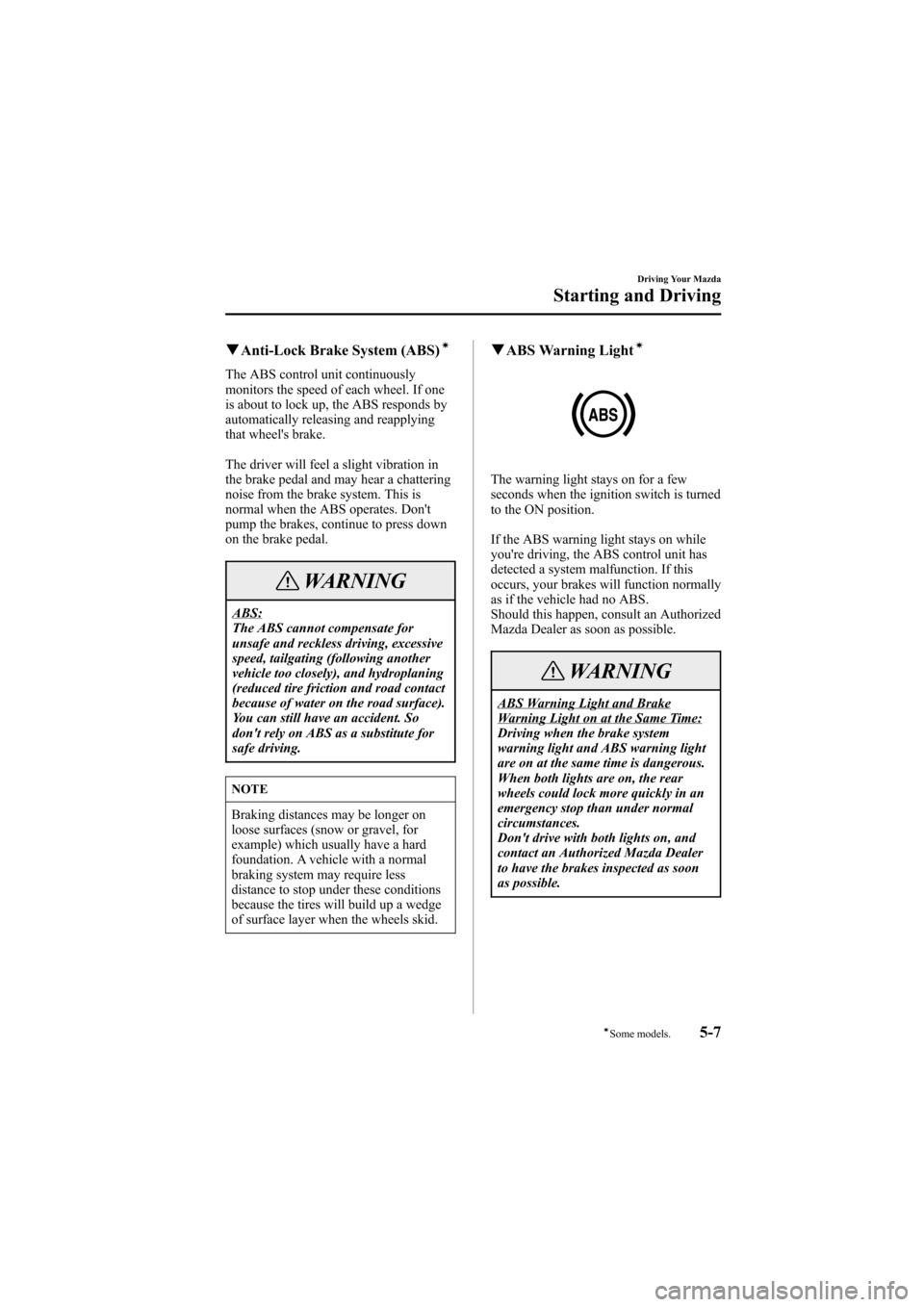
Black plate (131,1)
qAnti-Lock Brake System (ABS)í
The ABS control unit continuously
monitors the speed of each wheel. If one
is about to lock up, the ABS responds by
automatically releasing and reapplying
that wheel's brake.
The driver will feel a slight vibration in
the brake pedal and may hear a chattering
noise from the brake system. This is
normal when the ABS operates. Don't
pump the brakes, continue to press down
on the brake pedal.
WARNING
ABS:
The ABS cannot compensate for
unsafe and reckless driving, excessive
speed, tailgating (following another
vehicle too closely), and hydroplaning
(reduced tire friction and road contact
because of water on the road surface).
You can still have an accident. So
don't rely on ABS as a substitute for
safe driving.
NOTE
Braking distances may be longer on
loose surfaces (snow or gravel, for
example) which usually have a hard
foundation. A vehicle with a normal
braking system may require less
distance to stop under these conditions
because the tires will build up a wedge
of surface layer when the wheels skid.
qABS Warning Lightí
The warning light stays on for a few
seconds when the ignition switch is turned
to the ON position.
If the ABS warning light stays on while
you're driving, the ABS control unit has
detected a system malfunction. If this
occurs, your brakes will function normally
as if the vehicle had no ABS.
Should this happen, consult an Authorized
Mazda Dealer as soon as possible.
WARNING
ABS Warning Light and BrakeWarning Light on at the Same Time:
Driving when the brake system
warning light and ABS warning light
are on at the same time is dangerous.
When both lights are on, the rear
wheels could lock more quickly in an
emergency stop than under normal
circumstances.
Don't drive with both lights on, and
contact an Authorized Mazda Dealer
to have the brakes inspected as soon
as possible.
Driving Your Mazda
Starting and Driving
5-7íSome models. Mazda6_8T56-EC-04G_Edition2 Page131
Monday, November 15 2004 4:33 PM
Form No.8T56-EC-04G
Page 132 of 340
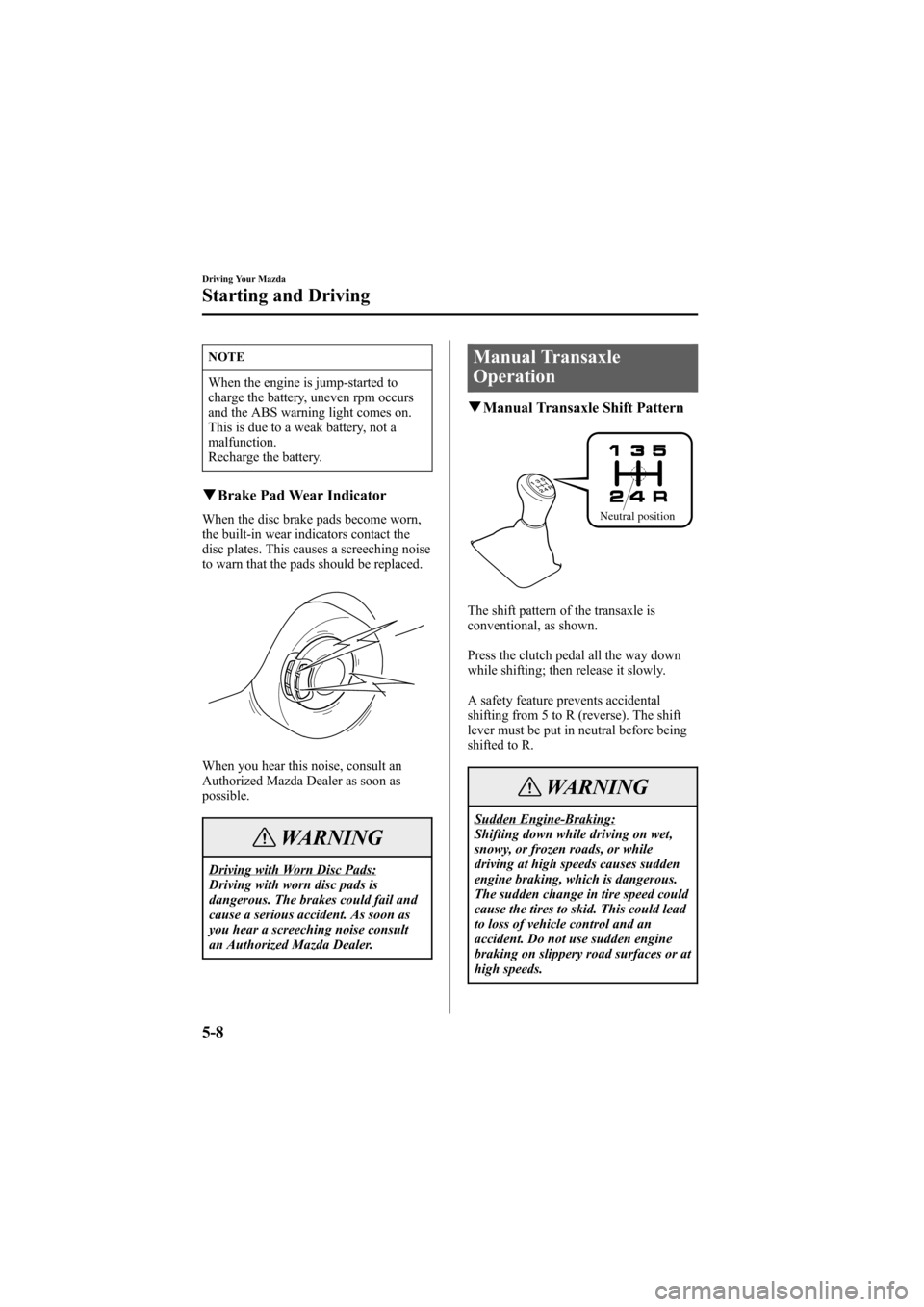
Black plate (132,1)
NOTE
When the engine is jump-started to
charge the battery, uneven rpm occurs
and the ABS warning light comes on.
This is due to a weak battery, not a
malfunction.
Recharge the battery.
qBrake Pad Wear Indicator
When the disc brake pads become worn,
the built-in wear indicators contact the
disc plates. This causes a screeching noise
to warn that the pads should be replaced.
When you hear this noise, consult an
Authorized Mazda Dealer as soon as
possible.
WARNING
Driving with Worn Disc Pads:
Driving with worn disc pads is
dangerous. The brakes could fail and
cause a serious accident. As soon as
you hear a screeching noise consult
an Authorized Mazda Dealer.
Manual Transaxle
Operation
qManual Transaxle Shift Pattern
Neutral position
The shift pattern of the transaxle is
conventional, as shown.
Press the clutch pedal all the way down
while shifting; then release it slowly.
A safety feature prevents accidental
shifting from 5 to R (reverse). The shift
lever must be put in neutral before being
shifted to R.
WARNING
Sudden Engine-Braking:
Shifting down while driving on wet,
snowy, or frozen roads, or while
driving at high speeds causes sudden
engine braking, which is dangerous.
The sudden change in tire speed could
cause the tires to skid. This could lead
to loss of vehicle control and an
accident. Do not use sudden engine
braking on slippery road surfaces or at
high speeds.
5-8
Driving Your Mazda
Starting and Driving
Mazda6_8T56-EC-04G_Edition2 Page132
Monday, November 15 2004 4:33 PM
Form No.8T56-EC-04G
Page 133 of 340

Black plate (133,1)
CAUTION
lKeep your foot off the clutch pedal
except when shifting gears. Also,
don't use the clutch to hold the
vehicle on an upgrade. Riding the
clutch will cause needless clutch
wear and damage.
lMake sure the vehicle comes to a
complete stop before shifting to R.
Shifting to R while the vehicle is still
moving may damage the transaxle.
NOTE
If shifting to R is difficult, shift back
into neutral, release the clutch pedal,
and try again.
qRecommendations for Shifting
Upshifting
2.3-liter engine
For normal acceleration, we recommend
these shift points.
Gear Vehicle speed
1 to 2 26 km/h (16 mph)
2 to 3 45 km/h (28 mph)
3 to 4 53 km/h (33 mph)
4 to 5 63 km/h (39 mph)
For cruising
Gear Vehicle speed
1 to 2 13 km/h (8 mph)
2 to 3 32 km/h (20 mph)
3 to 4 50 km/h (31 mph)
4 to 5 68 km/h (42 mph)
3.0-liter engine
For normal acceleration, we recommend
these shift points.
Gear Vehicle speed
1 to 2 27 km/h (17 mph)
2 to 3 48 km/h (30 mph)
3 to 4 56 km/h (35 mph)
4 to 5 63 km/h (39 mph)
For cruising
Gear Vehicle speed
1 to 2 13 km/h (8 mph)
2 to 3 34 km/h (21 mph)
3 to 4 52 km/h (32 mph)
4 to 5 66 km/h (41 mph)
Downshifting
When you must slow down in heavy
traffic or on a steepupgrade, downshift
before the engine starts to overwork. This
reduces the chance of stalling and gives
better acceleration when you need more
speed.
On a steep downgrade, downshifting
helps maintain safe speed and prolongs
brake life.
Driving Your Mazda
Starting and Driving
5-9
Mazda6_8T56-EC-04G_Edition2 Page133
Monday, November 15 2004 4:33 PM
Form No.8T56-EC-04G
Page 134 of 340

Black plate (134,1)
Automatic Transaxle Controls
Indicates that you must depress the brake pedal to shift (The ignition
switch must be in the ACC or ON position).
Indicates the shift lever can be shifted freely into any position.
Various Lockouts:
qTransaxle Ranges
The shift lever must be in P or N to
operate the starter.
P (Park)
P locks the transaxle and prevents the
front wheels from rotating.
WARNING
Holding the Vehicle with P:
Only setting the shift lever to the P
position without using the parking
brake to hold the vehicle is dangerous.
If P fails to hold, the vehicle could
move and cause an accident. To hold
the vehicle, set the shift lever to P AND
set the parking brake.
CAUTION
lShifting into P, N or R while the
vehicle is moving can damage your
transaxle.
lShifting into a driving gear or
reverse when the engine is running
faster than idle can damage the
transaxle.
R (Reverse)
In position R, the vehicle moves only
backward. You must be at a complete stop
before shifting to or from R, except under
rare circumstances as explained in
Rocking the Vehicle (page 4-8).
5-10
Driving Your Mazda
Starting and Driving
Mazda6_8T56-EC-04G_Edition2 Page134
Monday, November 15 2004 4:33 PM
Form No.8T56-EC-04G
Page 135 of 340
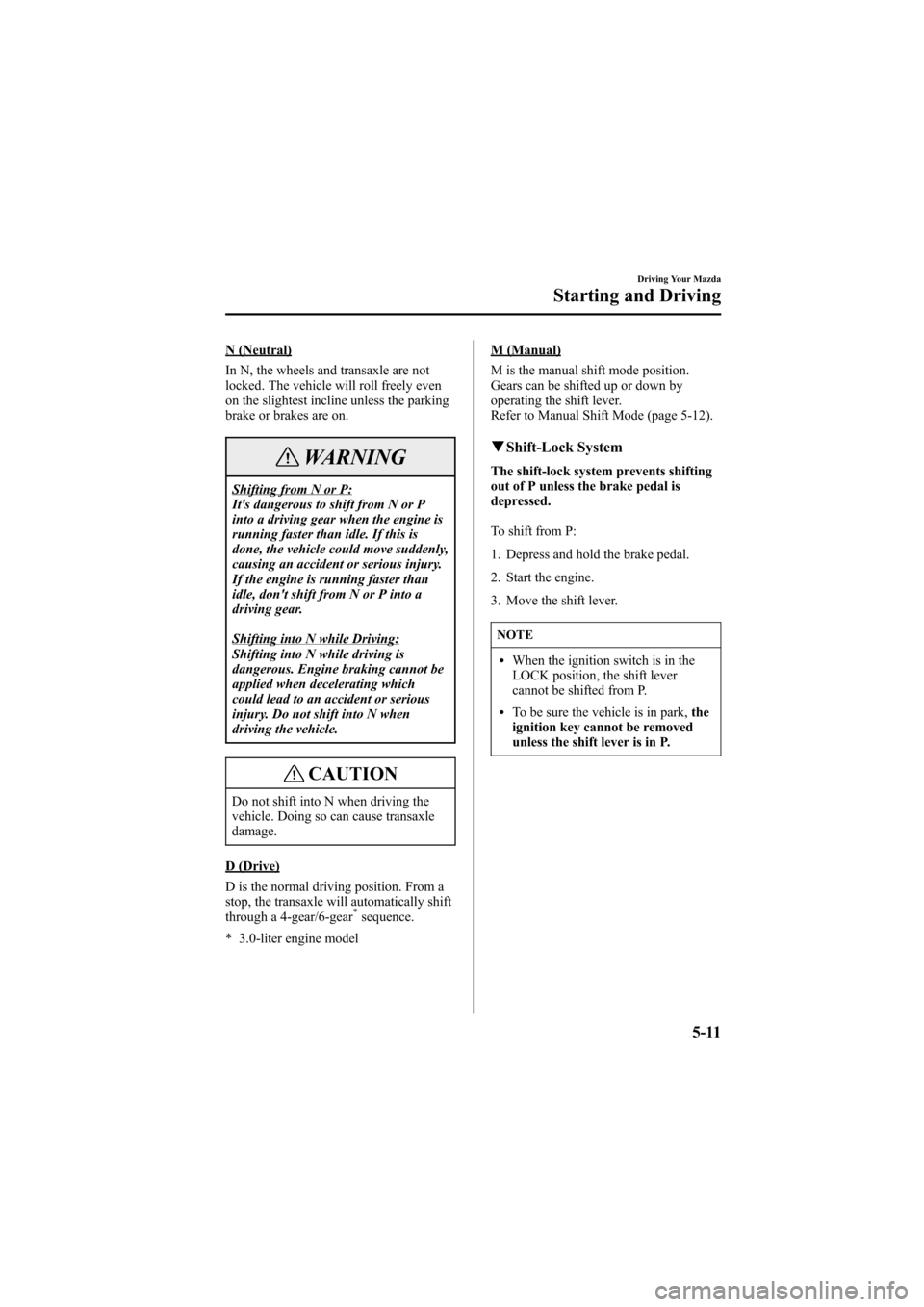
Black plate (135,1)
N (Neutral)
In N, the wheels and transaxle are not
locked. The vehicle will roll freely even
on the slightest incline unless the parking
brake or brakes are on.
WARNING
Shifting from N or P:
It's dangerous to shift from N or P
into a driving gear when the engine is
running faster than idle. If this is
done, the vehicle could move suddenly,
causing an accident or serious injury.
If the engine is running faster than
idle, don't shift from N or P into a
driving gear.
Shifting into N while Driving:
Shifting into N while driving is
dangerous. Engine braking cannot be
applied when decelerating which
could lead to an accident or serious
injury. Do not shift into N when
driving the vehicle.
CAUTION
Do not shift into N when driving the
vehicle. Doing so can cause transaxle
damage.
D (Drive)
D is the normal driving position. From a
stop, the transaxle will automatically shift
through a 4-gear/6-gear
*sequence.
* 3.0-liter engine model
M (Manual)
M is the manual shift mode position.
Gears can be shifted up or down by
operating the shift lever.
Refer to Manual Shift Mode (page 5-12).
qShift-Lock System
The shift-lock system prevents shifting
out of P unless the brake pedal is
depressed.
To shift from P:
1. Depress and hold the brake pedal.
2. Start the engine.
3. Move the shift lever.
NOTE
lWhen the ignition switch is in the
LOCK position, the shift lever
cannot be shifted from P.
lTo be sure the vehicle is in park,the
ignition key cannot be removed
unless the shift lever is in P.
Driving Your Mazda
Starting and Driving
5-11
Mazda6_8T56-EC-04G_Edition2 Page135
Monday, November 15 2004 4:33 PM
Form No.8T56-EC-04G
Page 136 of 340
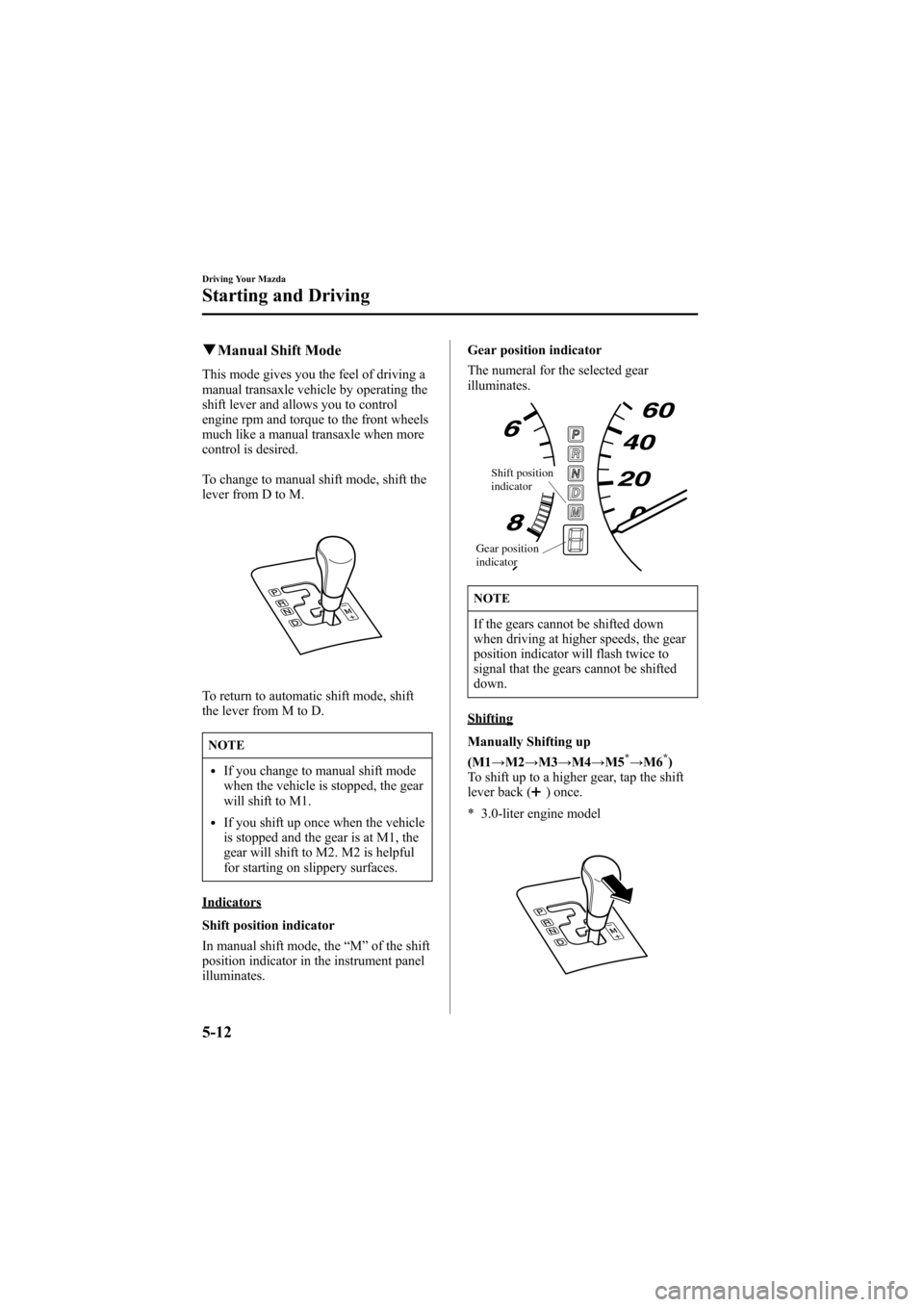
Black plate (136,1)
qManual Shift Mode
This mode gives you the feel of driving a
manual transaxle vehicle by operating the
shift lever and allows you to control
engine rpm and torque to the front wheels
much like a manual transaxle when more
control is desired.
To change to manual shift mode, shift the
lever from D to M.
To return to automatic shift mode, shift
the lever from M to D.
NOTE
lIf you change to manual shift mode
when the vehicle is stopped, the gear
will shift to M1.
lIf you shift up once when the vehicle
is stopped and the gear is at M1, the
gear will shift to M2. M2 is helpful
for starting on slippery surfaces.
Indicators
Shift position indicator
In manual shift mode, the“M”of the shift
position indicator in the instrument panel
illuminates.Gear position indicator
The numeral for the selected gear
illuminates.
Shift position
indicator
Gear position
indicator
NOTE
If the gears cannot be shifted down
when driving at higher speeds, the gear
position indicator will flash twice to
signal that the gears cannot be shifted
down.
Shifting
Manually Shifting up
(M1→M2→M3→M4→M5
*→M6*)
To shift up to a higher gear, tap the shift
lever back (
) once.
* 3.0-liter engine model
5-12
Driving Your Mazda
Starting and Driving
Mazda6_8T56-EC-04G_Edition2 Page136
Monday, November 15 2004 4:33 PM
Form No.8T56-EC-04G
Page 137 of 340
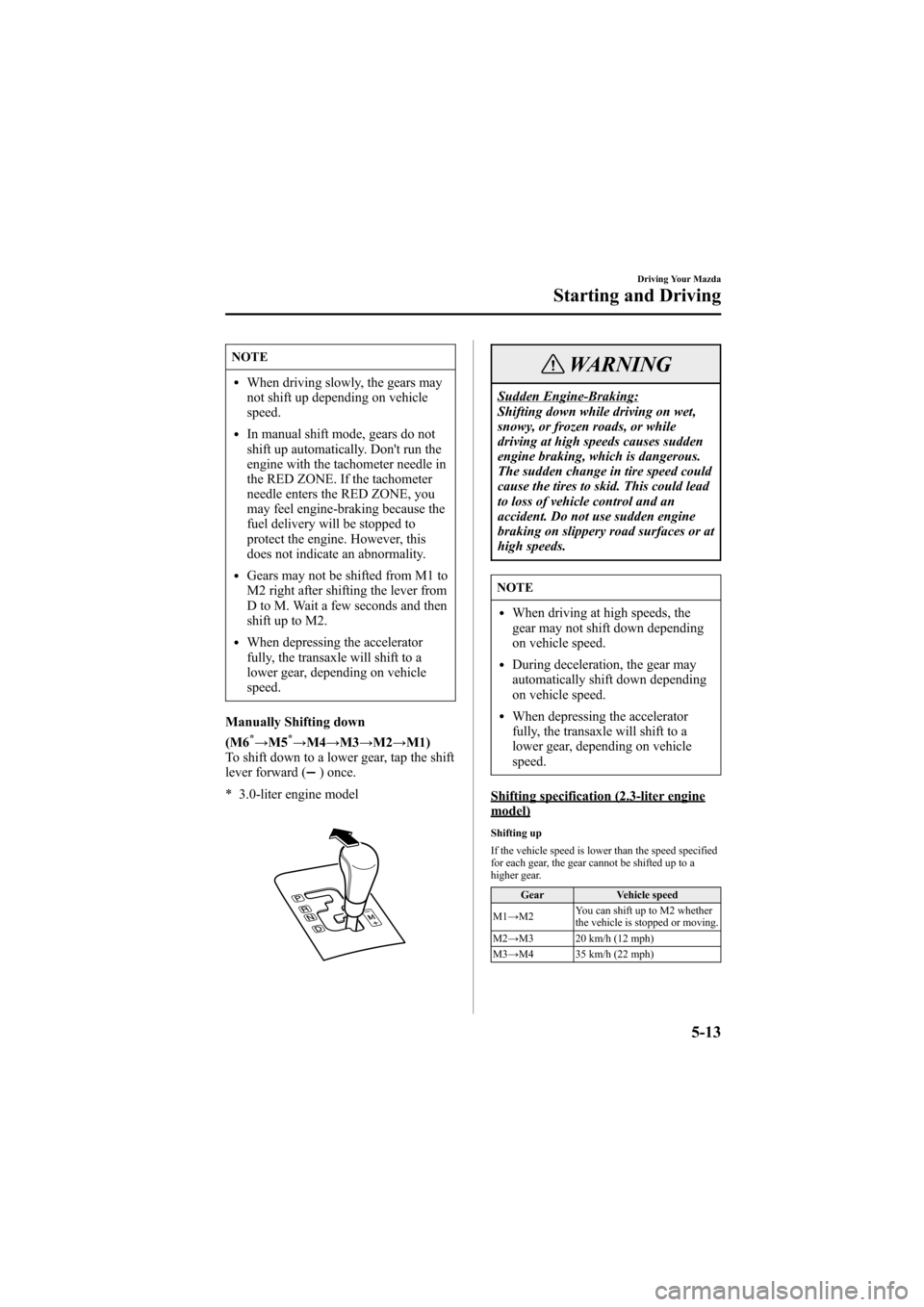
Black plate (137,1)
NOTE
lWhen driving slowly, the gears may
not shift up depending on vehicle
speed.
lIn manual shift mode, gears do not
shift up automatically. Don't run the
engine with the tachometer needle in
the RED ZONE. If the tachometer
needle enters the RED ZONE, you
may feel engine-braking because the
fuel delivery will be stopped to
protect the engine. However, this
does not indicate an abnormality.
lGears may not be shifted from M1 to
M2 right after shifting the lever from
D to M. Wait a few seconds and then
shift up to M2.
lWhen depressing the accelerator
fully, the transaxle will shift to a
lower gear, depending on vehicle
speed.
Manually Shifting down
(M6
*→M5*→M4→M3→M2→M1)
To shift down to a lower gear, tap the shift
lever forward (
) once.
* 3.0-liter engine model
WARNING
Sudden Engine-Braking:
Shifting down while driving on wet,
snowy, or frozen roads, or while
driving at high speeds causes sudden
engine braking, which is dangerous.
The sudden change in tire speed could
cause the tires to skid. This could lead
to loss of vehicle control and an
accident. Do not use sudden engine
braking on slippery road surfaces or at
high speeds.
NOTE
lWhen driving at high speeds, the
gear may not shift down depending
on vehicle speed.
lDuring deceleration, the gear may
automatically shift down depending
on vehicle speed.
lWhen depressing the accelerator
fully, the transaxle will shift to a
lower gear, depending on vehicle
speed.
Shifting specification (2.3-liter enginemodel)
Shifting up
If the vehicle speed is lower than the speed specified
for each gear, the gear cannot be shifted up to a
higher gear.
Gear Vehicle speed
M1→M2You can shift up to M2 whether
the vehicle is stopped or moving.
M2→M3 20 km/h (12 mph)
M3→M4 35 km/h (22 mph)
Driving Your Mazda
Starting and Driving
5-13
Mazda6_8T56-EC-04G_Edition2 Page137
Monday, November 15 2004 4:33 PM
Form No.8T56-EC-04G
Page 138 of 340

Black plate (138,1)
Shifting down
If the vehicle speed is higher than the speed specified
for each gear, the gear cannot be shifted down to a
lower gear.
Gear Vehicle speed
M4→M3 147 km/h (91 mph)
M3→M2 104 km/h (64 mph)
M2→M1 44 km/h (27 mph)
During deceleration, the gears shift down
automatically when speed is reduced to the
following:
Gear Vehicle speed
M4→M3 31 km/h (19 mph)
M3 or M2→M1 12 km/h (7 mph)
NOTE
If the vehicle is driven at a low speed
from a standing start while in M2, the
gear may not shift down to M1
automatically.
If the vehicle is kicked down at the following speeds
or lower, the gears shift down automatically:
Gear Vehicle speed
M4→M3 140 km/h (86 mph)
M3→M2 56 km/h (34 mph)
Shifting specification (3.0-liter enginemodel)
Shifting up
If the vehicle speed is lower than the speed specified
for each gear, the gear cannot be shifted up to a
higher gear.
Gear Vehicle speed
M1→M2You can shift up to M2 whether
the vehicle is stopped or moving.
M2→M3 10 km/h (6 mph)
M3→M4 23 km/h (14 mph)
M4→M5 39 km/h (24 mph)
M5→M6 49 km/h (30 mph)Shifting down
If the vehicle speed is higher than the speed specified
for each gear, the gear cannot be shifted down to a
lower gear.
Gear Vehicle speed
M5→M4 175 km/h (109 mph)
M4→M3 130 km/h (81 mph)
M3→M2 83 km/h (52 mph)
M2→M1 43 km/h (27 mph)
During deceleration, the gears shift down
automatically when speed is reduced to the
following:
Gear Vehicle speed
M6→M5Between 50 and 212 km/h
(31 and 131 mph), depending on
how much the accelerator pedal
is released.
M5→M4Between 38 and 161 km/h
(23 and 100 mph), depending on
how much the accelerator pedal
is released.
M4→M3Between 23 and 70 km/h
(14 and 44 mph), depending on
how much the accelerator pedal
is released.
M3→M2Between 10 and 46 km/h
(6 and 28 mph), depending on
how much the accelerator pedal
is released.
M2→M1 10 km/h (6 mph)
NOTE
If the vehicle is driven at a low speed
from a standing start while in M2, the
gear may not shift down to M1
automatically.
5-14
Driving Your Mazda
Starting and Driving
Mazda6_8T56-EC-04G_Edition2 Page138
Monday, November 15 2004 4:33 PM
Form No.8T56-EC-04G
Page 139 of 340
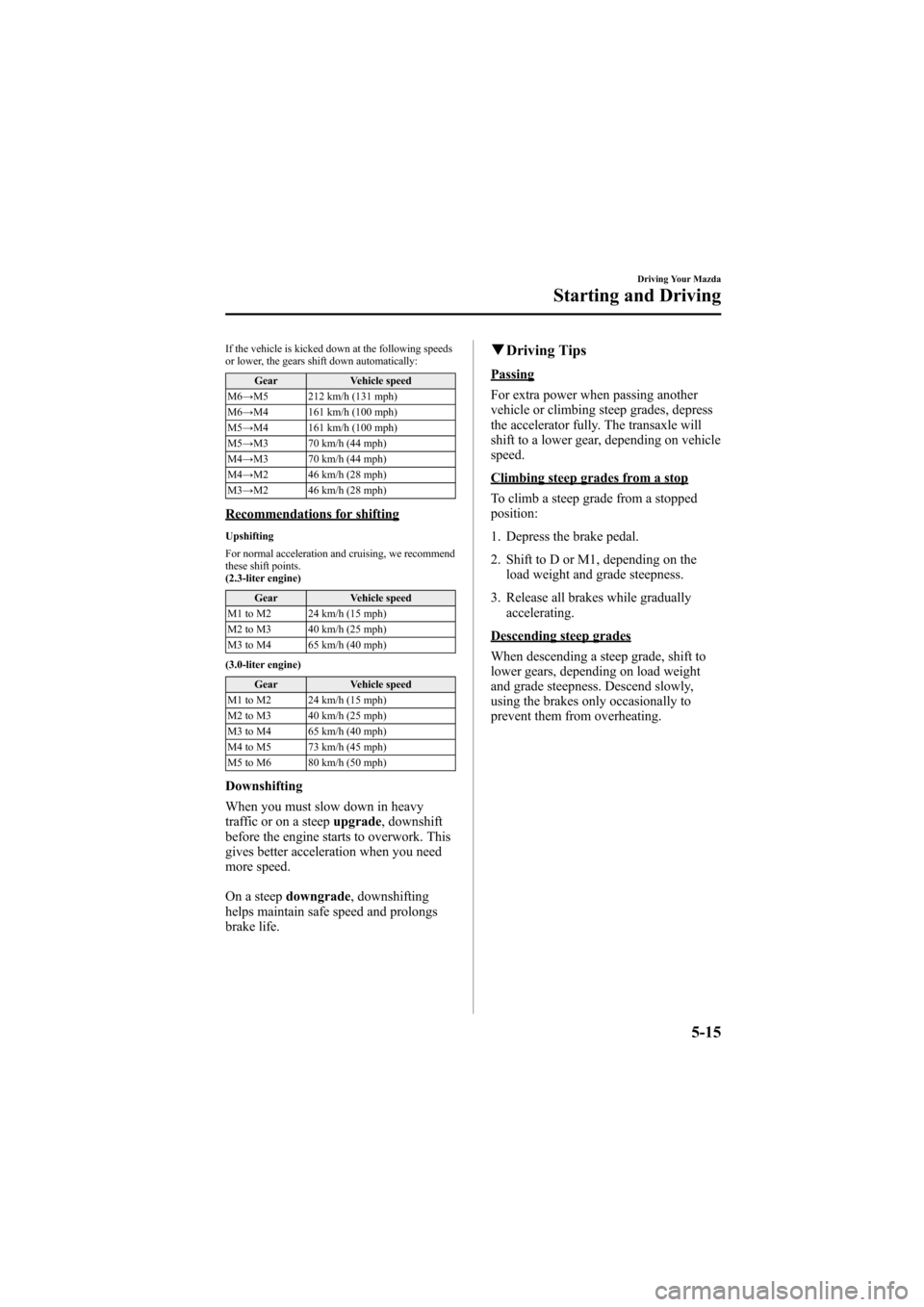
Black plate (139,1)
If the vehicle is kicked down at the following speeds
or lower, the gears shift down automatically:
Gear Vehicle speed
M6→M5 212 km/h (131 mph)
M6→M4 161 km/h (100 mph)
M5→M4 161 km/h (100 mph)
M5→M3 70 km/h (44 mph)
M4→M3 70 km/h (44 mph)
M4→M2 46 km/h (28 mph)
M3→M2 46 km/h (28 mph)
Recommendations for shifting
Upshifting
For normal acceleration and cruising, we recommend
these shift points.
(2.3-liter engine)
Gear Vehicle speed
M1 to M2 24 km/h (15 mph)
M2 to M3 40 km/h (25 mph)
M3 to M4 65 km/h (40 mph)
(3.0-liter engine)
Gear Vehicle speed
M1 to M2 24 km/h (15 mph)
M2 to M3 40 km/h (25 mph)
M3 to M4 65 km/h (40 mph)
M4 to M5 73 km/h (45 mph)
M5 to M6 80 km/h (50 mph)
Downshifting
When you must slow down in heavy
traffic or on a steepupgrade, downshift
before the engine starts to overwork. This
gives better acceleration when you need
more speed.
On a steepdowngrade, downshifting
helps maintain safe speed and prolongs
brake life.
qDriving Tips
Passing
For extra power when passing another
vehicle or climbing steep grades, depress
the accelerator fully. The transaxle will
shift to a lower gear, depending on vehicle
speed.
Climbing steep grades from a stop
To climb a steep grade from a stopped
position:
1. Depress the brake pedal.
2. Shift to D or M1, depending on the
load weight and grade steepness.
3. Release all brakes while gradually
accelerating.
Descending steep grades
When descending a steep grade, shift to
lower gears, depending on load weight
and grade steepness. Descend slowly,
using the brakes only occasionally to
prevent them from overheating.
Driving Your Mazda
Starting and Driving
5-15
Mazda6_8T56-EC-04G_Edition2 Page139
Monday, November 15 2004 4:33 PM
Form No.8T56-EC-04G
Page 140 of 340
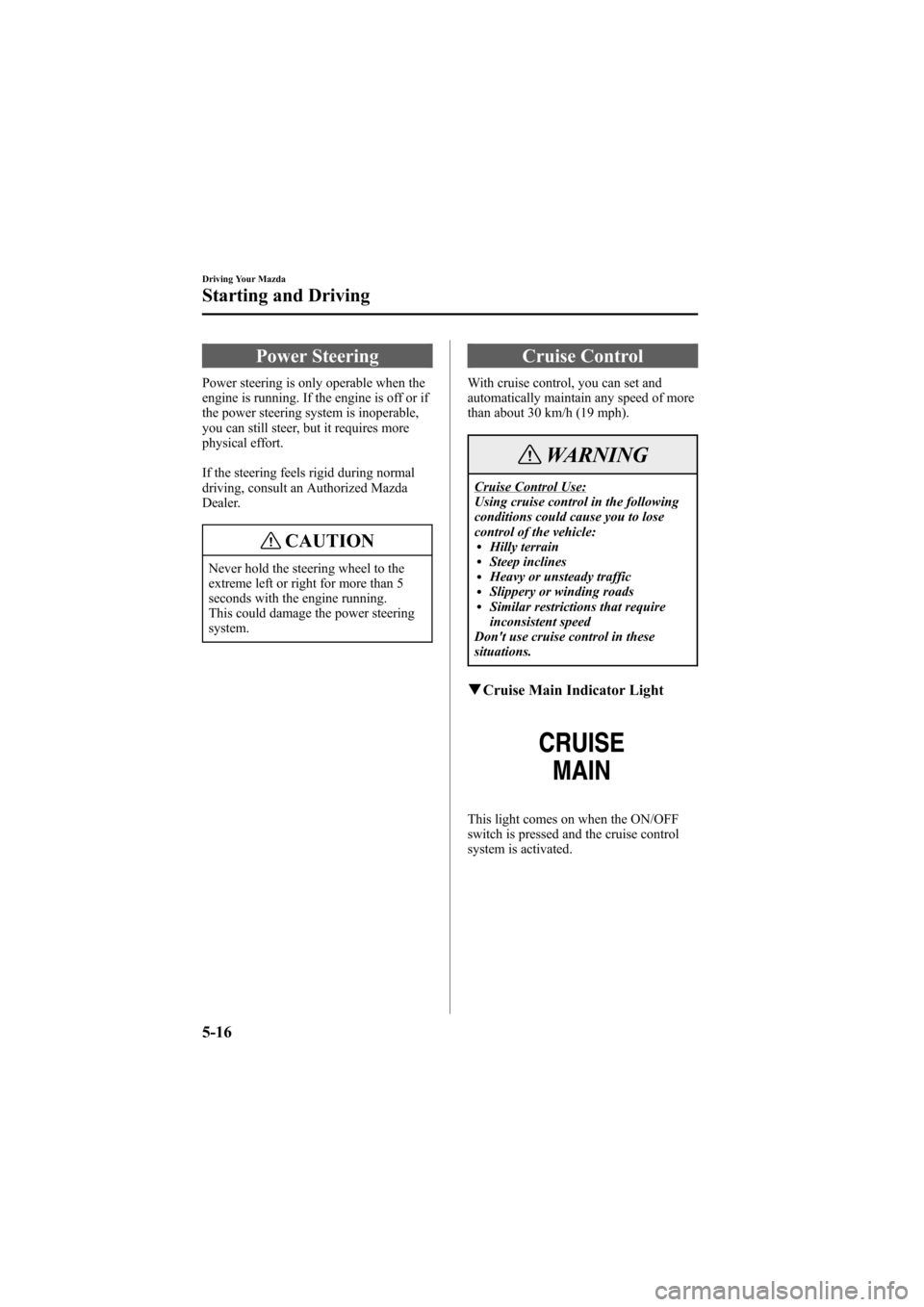
Black plate (140,1)
Power Steering
Power steering is only operable when the
engine is running. If the engine is off or if
the power steering system is inoperable,
you can still steer, but it requires more
physical effort.
If the steering feels rigid during normal
driving, consult an Authorized Mazda
Dealer.
CAUTION
Never hold the steering wheel to the
extreme left or right for more than 5
seconds with the engine running.
This could damage the power steering
system.
Cruise Control
With cruise control, you can set and
automatically maintain any speed of more
than about 30 km/h (19 mph).
WARNING
Cruise Control Use:
Using cruise control in the following
conditions could cause you to lose
control of the vehicle:
lHilly terrainlSteep inclineslHeavy or unsteady trafficlSlippery or winding roadslSimilar restrictions that require
inconsistent speed
Don't use cruise control in these
situations.
qCruise Main Indicator Light
This light comes on when the ON/OFF
switch is pressed and the cruise control
system is activated.
5-16
Driving Your Mazda
Starting and Driving
Mazda6_8T56-EC-04G_Edition2 Page140
Monday, November 15 2004 4:33 PM
Form No.8T56-EC-04G